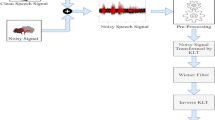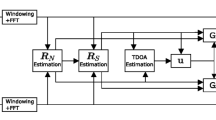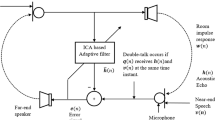Abstract
An innovative acoustic noise canceling method using adaptive Wiener filtering (AWF) was developed for improved acquisition of distortion product otoacoustic emissions (DPOAEs). The system used one microphone placed in the test ear for the primary signal. Noise reference signals were obtained from three different sources: (a) pre-stimulus response from the test ear microphone, (b) post-stimulus response from a microphone placed near the head of the subject and (c) post-stimulus response obtained from a microphone placed in the subject’s nontest ear. In order to improve spectral estimation, block averaging of a different number of single sweep responses was used. DPOAE data were obtained from 11 ears of healthy newborns in a well-baby nursery of a hospital under typical noise conditions. Simultaneously obtained recordings from all three microphones were digitized, stored and processed off-line to evaluate the effects of AWF with respect to DPOAE detection and signal-to-noise ratio (SNR) improvement. Results show that compared to standard DPOAE processing, AWF improved signal detection and improved SNR. © 1998 Biomedical Engineering Society.
PAC98: 4364Jb, 4360-c, 8790+y
Similar content being viewed by others
REFERENCES
Berger, E. H., and M. C. Killion. Comparison of the noise attenuation of three audiometric earphones, with additional data on masking near threshold. J. Acoust. Soc. Am.86:1392-1403, 1989.
Bertrand, O., L. Garcia-Larrea, F. Artru, F. Mauguiere, and J. Pernier. Brain-stem monitoring. I. A system for high rate sequential BAEP recording and feature extraction. Electroencephalogr. Clin. Neurophysiol.68:433-445, 1987.
Brownell, W. E. Outer hair cell electromotility and otoacoustic emissions. Ear Hear.11:82-92, 1990.
De Weerd, J. P. C. Facts and Fancies about a posteriori“Wiener” filtering. IEEE Trans. Biomed. Eng.28:252-257, 1981.
De Weerd, J. P. C., and W. L. J. Martens. Theory and practice of a posteriori “Wiener” filtering of average evoked potentials. Biol. Cybern.30:81-94, 1978.
Gaskill, S. A., and A. M. Brown. The behavior of the otoacoustic distortion product 2 f1-f2 from the human ear and its relationship to auditory sensitivity. J. Acoust. Soc. Am.88:821-839, 1990.
Grandori, F. Nonlinear phenomena in click and tone-burst evoked otoacoustic emissions from human ears. Audiology24:71-80, 1985.
Hall, J. W., III, J. E. Bear, P. A. Chase, and K. A. Rupp. Transient and distortion product otoacoustic emissions in infant hearing screening. In: Proceedings of the Meeting of the American Academy of Audiology, Richmond, VA, 1994.
Harris, F. P., B. L. Lonsbury-Martin, B. B. Stagner, A. C. Coats, and G. K. Martin. Acoustic distortion products in humans: Systematic changes in amplitude as a function of f1/f2 ratio. J. Acoust. Soc. Am.85:131-141, 1989.
Kemp, D. T. Stimulated acoustic emissions from within the human auditory system. J. Acoust. Soc. Am.64:1386-1391, 1978.
Kemp, D. T., and S. Ryan. Otoacoustic emission tests in neonatal screening programmes. Acta Oto-Laryngol. Suppl.482:73-84, 1991.
Kemp, D. T., S. Ryan, and P. Bray. A guide to the effective use of otoacoustic emissions. Ear Hear.11:93-105, 1990.
Lindquist, C. S. Adaptive and Digital Signal Processing. Miami, FL: Steward and Sons, 1989.
Lonsbury-Martin, B. L., F. P. Harris, M. D. Hawkins, B. B. Stagner, and G. K. Martin. Distortion products emissions in humans: I. Basic properties in normally hearing subjects. Ann. Otol. Rhinol. Laryngol.(Suppl. 147) 99:3-13, 1990.
Martin, G. K., M. L. Whitehead, and B. L. Lonsbury-Martin. Potential of evoked otoacoustic emissions for infant hearing screening. Semin. Hear.11:185-204, 1990.
NIH Consensus Development Conference. Early identification of hearing impairment in infants and young children. National Institutes of Health Consensus Statement 11(1):1- 24, 1993.
Nogowa, T., K. Katayama, Y. Tabata, T. Kawahara, and T. Ohshio. Visual evoked potentials estimated by Wiener filtering. Electroencephalogr. Clin. Neurophysiol.35:375-378, 1973.
Norton, S. J. Application of transient evoked otoacoustic emissions to pediatric populations. Ear Hear.14:64-73, 1993.
Probst, R., B. L. Lonsbury-Martin, and G. K. Martin. A review of otoacoustic emissions. J. Acoust. Soc. Am.89:2027-2069, 1991.
Ravazzani, P., and F. Grandori. Evoked otoacoustic emissions: Nonlinearities and response interpretation. IEEE Trans. Biomed. Eng.40:500-504, 1993.
Ungan, P., and E. Basar. Comparison of Wiener filtering and selective averaging of evoked potentials. Electroencephalogr. Clin. Neurophysiol.40:516-520, 1976.
Walter, D. O. A posteriori “Wiener filtering” of averaged evoked responses. Electroencephalogr. Clin. Neurophysiol. Suppl.27:61-70, 1969.
Wastell, D. G. When Wiener filtering is less than optimal: An illustrative application to the brain stem evoked potential. Electroencephalogr. Clin. Neurophysiol.51:678-682, 1981.
White, K. R., B. R. Vohr, and T. R. Behrens. Universal newborn screening using transient evoked otoacoustic emissions: results of the Rhode Island Hearing Assessment Project. Semin. Hear.14:18-29, 1993.
Wiener, N. Extrapolation, Interpolation and Smoothing of Stationary Time Series. New York: Wiley, 1949.
Author information
Authors and Affiliations
Rights and permissions
About this article
Cite this article
Özdamar, Ö., Delgado, R.E., Rahman, S. et al. Adaptive Wiener Filtering for Improved Acquisition of Distortion Product Otoacoustic Emissions. Annals of Biomedical Engineering 26, 883–891 (1998). https://doi.org/10.1114/1.111
Issue Date:
DOI: https://doi.org/10.1114/1.111




